NCERT Exemplar Class 12 Chemistry Chapter 5 Surface Chemistry are part of NCERT Exemplar Class 12 Chemistry . Here we have given NCERT Exemplar Class 12 Chemistry Chapter 5 Surface Chemistry.
NCERT Exemplar Class 12 Chemistry Chapter 5 Surface Chemistry
Multiple Choice Questions
Single Correct Answer Type
Question 1. Which of the following process does not occur at the interface of phases?
(a) Crystallisation (b) Heterogeneous catalysis
(c) Homogeneous catalysis ’ (d) Corrosion –
Solution:
(c) There is no homogeneous catalysis.
Question 2. At the equilibrium position in the process of adsorption
![]()
Solution:
![]()
Question 3. Which of the following interface cannot be obtained?
(a) Liquid-liquid (b) Solid-liquid
(c) Liquid-gas (d) Gas-gas
Solution:
(d) Gas-gas interface cannot be obtained as they are completely miscible in nature.
For example, air is a mixture of various gases such as, 02, N2, C02, etc.
Question 4. The term ‘sorption’ stands for
(a) absorption (b) adsorption
(c) both absorption and adsorption (d) desorption
Solution:
(c) Adsorption and absorption when take place together, it is known as sorption.
Question 5. Extent of physisorption of a gas increases with
(a) increase in temperature
(b) decrease in temperature
(c) decrease in surface area of adsorbent
(d) decrease in strength of van der Waals forces
Solution:
(b) Physical adsorption of a gas increases with decrease in temperature because, at higher temperature weak van der Waals forces between gas and the surface become difficult to exist.
Question 6. Extent of adsorption of adsorbate from solution phase increases with
(a) increase in amount of adsorbate in solution
(b) decrease in surface area of adsorbent
(c) increase in temperature of solution
(d) decrease in amount of adsorbate in solution
Solution:
(a) Extent of adsorption of adsorbate from solution phase increases with increase in the amount of adsorbate in the solution. As amount of adsorbate in the solution increases interaction of adsorbent increases which leads to increase in extent of adsorption.
Question 7. Which one of the following is not applicable to the phenomenon of adsorption?

Solution:
(a) Adsorption is an exothermic process. So,
![]()
Question 8. Which of the following is not a favourable condition for physical adsorption?
(a) High pressure
(b) Negative AH
(c) Higher critical temperature of adsorbate
(d) High temperature
Solution:
(d) Physical adsorption is favoured at low temperature.
Question 9. Physical adsorption of a gaseous species may change to chemical adsorption with
(a) decrease in temperature
(b) increase in temperature
(c) increase in surface area of adsorbent
(d) decrease in surface area of adsorbent
Solution:
(b) On increasing temperature physisorption changes to chemisorption. As the temperature increases, energy of activation of adsorbate particles increases which leads to formation of chemical bond between adsorbate and adsorbent. Hence, physisorption transform into chemisorption.
Question 10. In physisorption, adsorbent does not show specificity for any particular gas because
(a) involved van der Waals forces are universal
(b) gases involved behave like ideal gases.
(c) enthalpy of adsorption is low
(d) it is a reversible process ,
Solution:
(a) Physisorption is not specific to any gas since it involves van der Waals forces and no specific bonds are formed.
Question 11. Which of the following is an example of absorption?
(a) Water on silica gel
(b) Water on calcium chloride
(c) Hydrogen on finely divided nickel
(d) Oxygen on metal surface
Solution:
(b) Calcium chloride absorbs water. Other examples show adsorption.
Question 12. On the basis of data given below predict which of the following gases shows least adsorption on a definite amount of charcoal?

Solution:
(d) The lesser the value of critical temperature of gases the lesser will be the extent of adsorption. Here H
2
has lowest value of critical temperature, i.e., 33.
Hence, hydrogen gas shows least adsorption on a definite amount of charcoal.
Question 13. In which of the following reactions heterogeneous catalysis involved?
(i) 2SO
2
(g) + O
2
(g)–>2SO
2
(g)
(ii) 2SO
2
(g)–> 2SO
3(g)
(iii) N
2
(g) + 3H
2
(g) –>2NH
3(g)
(iv) CH
3COOCH
3(l) + H
2O
(l) HCI —> CH
3COOH(aq) + CH
3OH(aq)
(a) (ii), (iii) (b) (ii), (iii), (iv)
(c) (i), (ii), (iii) (d) (iv)
Solution:
(a) In reaction (ii) and reaction (iii), catalysts are in solid state, and reactants and products are gases.
Question 14. At high concentration of soap in water, soap behaves as
(a) molecular colloid (b) associated colloid
(c) macromolecular colloid (d) lyophilic colloid .
Solution:
(b) At low concentration soap behaves as strong electrolyte but at higher concentration it behaves as colloid due to formation of aggregates called micelles. These are known as associated colloids.
Question 15. Which of the following will show Tyndall effect?
(a) Aqueous solution of soap below critical micelle concentration.
(b) Aqueous solution of soap above critical micelle concentration.
(c) Aqueous solution of sodium chloride.
(d) Aqueous solution of sugar.
Solution:
(b) Aqueous solution of soap above critical micelle concentration leads to the formation of colloidal solution. Tyndall effect is a characteristic of colloidal solution in which colloidal particles show a coloured appearance when sunlight is passes through it and seen perpendicularly.
Q
uestion 16. Method by which lyophobic sol can be protected?
(a) By addition of oppositely charged sol
(b) By addition of an electrolyte
(c) By addition of lyophilic sol
(d) By boiling
Solution:
(c) Lyophobic sol can be protected by adding lyophilic sol which is known as protective colloid.
Question 17. Freshly prepared precipitate sometimes gets converted to colloidal solution by •
(a) coagulation (b) electrolysis
(c) diffusion . (d) peptisation
Solution:
(d) Peptisation is the process of converting freshly prepared precipitate into colloid.
Question 18. Which of the following electrolytes will have maximum coagulating value

Solution:
(b) According to Hardy-Schulze law, the greater the charge on anion, the greater will be its coagulating power.
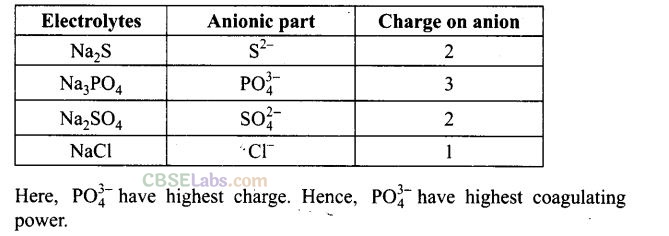
Question 19. A colloidal system having a solid substance as a dispersed phase and a liquid
as a dispersion medium is classified as
(a) solid sol (b) gel (c) emulsion (d) sol
Solution:
(d) It is called sol.
Question 20. The values of colligative properties of colloidal solution are of small order in
comparison to those shown by true solutions of same concentration because colloidal particles
(a) exhibit enormous surface area
(b) remain suspended in the dispersion medium
(c) form .lyophilic colloids
(d) are comparatively less in number
Solution:
(d) Colloidal particles are large in size and less in number.
Question 21. Arrange the following diagrams in correct sequence of steps involved in the mechanism of catalysis, in accordance with modem adsorption theory.
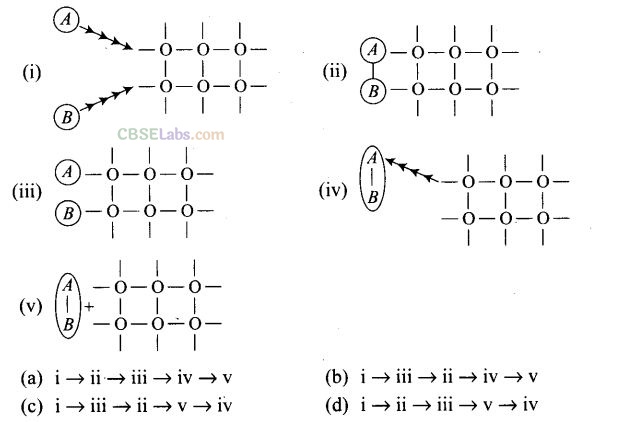
Solution:
(b) Correct sequence is i —» iii -» ii —»iv -> v
Each transformation denotes a meaningful process as follows
i —»adsorption of A and B on surface
iii —»ii interaction between A and B to form intermediate
ii —»iv starting desorption of A-B
iv —» v complete desorption
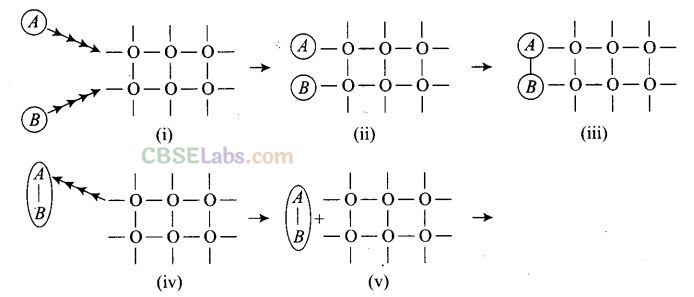
Question 22. Which of the following process is responsible for the formation of delta at a place where rivers meet the sea?
(a) Emulsification (b) Colloid formation
(c) Coagulation (d) Peptisatioti
Solution:
(c) A delta is formed at a place where rivers meet the sea due to the process of setting down of colloidal particles. The ions which are present in sea water are responsible for coagulation.
Question 23. Which of the following curves is in accordance with Freundlich adsorption isotherm?
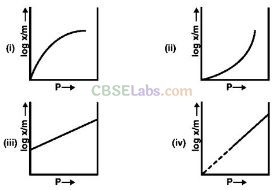
Solution:

Question 24. Which of the following process is not responsible for the presence of electric charge on the sol particles?
(a) Electron capture by sol particles
(b) Adsorption of ionic species from solution
(c) Formation of Helmholtz electrical double layer
(d) Absorption of ionic species from solution
Solution:
(d) Absorption of ionic species from solution is not responsible for the presence of electric charge on the sol particles. Charge on the sol particles is due to
(i) electrons capture by sol particles during electro dispersion of metal.
(ii) preferential adsorption of ionic species from solution.
(iii) formation of Helmholtz electrical double layer.
Question 25. Which of the following phenomenon is applicable to the process shown in the figure?
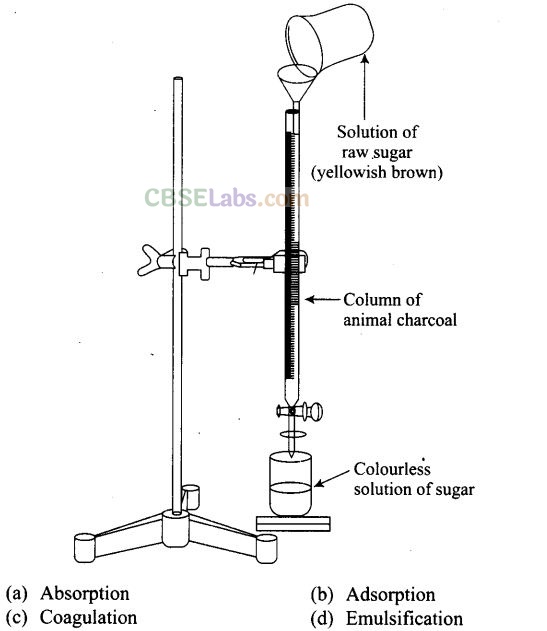
Solution:
(b) Colour is adsorbed on animal charcoal, hence sugar solution which comes out from the column is colourless.
More than One Correct Answer Type
Question 26. Which of the following options are correct?
(a) Micelle formation by soap in aqueous solution is possible at all temperatures.
(b) Micelle formation by soap in aqueous solution occurs above a particular concentration.
(c) On dilution of soap solution micelles may revert to individual ions.
(d) Soap solution behaves as a normal strong electrolyte at all concentrations.
Solution:
(b, c) Micelle formation is possible only above critical micelle concentration
and on dilution the micelles may form electrolytes.
Question 27. Which of the following statements are correct about solid catalyst?
(a) Same reactants may give different product by using different catalysts.
(b) Catalyst does not change AH of reaction.
(c) Catalyst is required in large quantities to catalyse reactions.
(d) Catalytic activity of a solid catalyst does not depend upon the strength of chemisorption.
Solution:
(a, b)
(a) Same reactants may give different products by using different catalysts as different catalysis have different specific functions to mould the reaction towards specific product, e.g., starting with H2 and CO, and using different catalysts, we get different products.

Question 28. Freundlich adsorption isotherm is given by the expression x/m=KP
1/n
. Which of the following conclusions can be drawn from this expression?

Solution:

Question 29. H
2
gas is adsorbed on activated charcoal to a very little extent in comparison
to easily liquefiable gases due to
(a) very strong van der Waals interaction
(b) very weak van der Waals forces
(c) very low critical temperature
(d) very high critical temperature.
Solution:
(b, c) Due to weak van der Waals forces and very low critical temperature, H
2
is adsorbed to a limited extent.
Question 30. Which of the following statements are correct?
(a) Mixing two oppositely charged sols neutralizes their charges and stabilizes the colloid.
(b) Presence of equal and similar charges on colloidal particles provides stability to the colloids.
(c) Any amount of dispersed liquid can be added to emulsion without destabilizing it.
(d) Brownian movement stabilizes sols.
Solution:
(b, d) Presence of equal and similar charges on colloidal particles provides stability to colloids as repulsive forces between charge particles having same charge prevent them from colliding when they come closer to each other.
Question 31. An emulsion cannot be broken by and
(a) heating
(b) adding more amount of dispersion medium
(c) freezing
(d) adding emulsifying agent
Solution:
(b, d) An emulsion cannot be broken by adding more amount of dispersion medium and emulsifying agent. It can be broken by heating, freezing, etc.
Question 32. Which of the following substances will precipitate the negatively charged emulsions?
(a) KCl (b) Glucose
(c) Urea (d) NaCl
Solution:
(a, d) KCl and NaCl contain K
+
and Na
+
which will precipitate negatively charged emulsions.
Question 33. Which of the following colloids cannot be coagulated easily?
(a) Lyophobic colloids (b) Irreversible colloids
(c) Reversible colloids (d) Lyophilic colloids
Solution:
(c, d) Lyophilic colloids (liquid loving colloids) which are also known as reversible colloid cannot be coagulated easily. The stability of these colloids are due to
(i) Charge on colloidal particles and
(ii) Solvation of colloidal particles.
Question 34. What happens when a lyophilic sol is added to a lyophobic sol?
(a) Lyophobic sol is protected.
(b) Lyophilic sol is protected.
(c) Film of lyophilic sol is formed over lyophobic sol.
(d) Film of lyophobic sol is formed over lyophilic sol.
Solution:
(a, c) Lyophobic sols are protected due to formation of film of lyophobic sol.
Question 35. Which phenomenon occurs when an electric field is applied to a-colloidal solution and electrophoresis is prevented?
(a) Reverse osmosis takes place.
(b) Electroosmosis takes place.
(c) Dispersion medium begins to move.
(d) Dispersion medium becomes stationary.
Solution:
(b, c) The dispersion medium begins to move in an electric field when electrophoresis is prevented. This is known as electroosmosis.
Question 36. In a reaction, catalyst changes
(a) physically (b) qualitatively
(c) chemically (d) quantitatively
Solution:
(a, b) In a reaction catalyst changes physically and qualitatively as it is unaltered during the reaction and remain quantitatively intact after completion of reaction, and does not change chemically.
Question 37. Which of the following phenomenon occurs when a chalk stick is dipped in ink?
(a) Adsorption of coloured substance
(b) Adsorption of solvent
(c) Absorption and adsorption both of solvent
(d) Absorption of solvent.
Solution:
(a, d) Both adsorption and absorption take place. Coloured substance is adsorbed while solvent is absorbed.
Short Answer Type Questions
Question 38. Why is it important to have clean surface in surface studies?
Solution:
Clean surface of adsorbent is suitable for adsorption because if surface is covered with gases of air, it will not be available for adsorption.
Question 39. Why is chemisorption referred to as activated adsorption?
Solution:
Chemisorption involves formation of bonds for which activation energy is required. That is why chemisorption is referred to as activated adsorption.
Question 40. What type of solutions are formed on dissolving different concentrations of soap in water?
Solution:
At lower concentration, soap forms a normal electrolytic solution with water. After a certain concentration called critical micelle concentration, colloidal solution is obtained.
Question 41. What happens when gelatin is mixed with gold sol?
Solution:
Gelatin stabilises the colloidal solution of gold. Gold sol is lyophobic sol or solvent repelling sol.
Question 42. How does it become possible to cause artificial rain by spraying silver iodide on the clouds?
Solution:
Clouds are colloidal in nature and carry a charge. On spraying silver iodide which is an electrolyte, the charge on the colloidal particles is neutralised. Clouds coagulate to form rain.
Question.43. Gelatin which is a peptide added in ice-creams. What can be its role?
Solution:
Ice-cream is an emulsion. Gelatin is emulsifying agent which is used to stabilize the emulsion so it is added to ice-creams.
Question 44. What is collodion?
Solution:
4% solution of cellulose nitrate in the mixture of alcohol and ether is called collodion. It is used to filter, colloidal solution.
Question 45. Why do we add alum to purify water?
Solution:
River water carries negatively charged colloidal particles of clay and sand; alum (K
2
SO
4
Al
2
(SO
4
)
3
24H
2
O) is added to river water to coagulate the colloidal particles of clay and sand. Thus, alum helps to purify water.
Question 46. What happens when electric field is applied to colloidal solution?
Solution:
When electric field is applied to colloidal solution then charged colloidal particles move towards oppositely charged electrodes. This phenomenon is called electrophoresis.
Question 47. What causes Brownian motion in colloidal dispersion?
Solution:
Brownian movement is the continuous zigzag movement of colloidal particles in a colloidal sol. Brownian motion takes place due to collision between the molecules of dispersion medium and colloidal particles. This movement is responsible for stabilisation of colloidal solution.
Question 48. A colloid is formed by adding FeCl
3
in excess of hot water. What will happen if excess sodium chloride is added to this colloid?
Solution:
A positively charged colloidal solution of hydrated ferric oxide is formed. On adding sodium chloride, negatively charged chloride ions neutralise the positive charge of the colloidal solution. Coagulation of the sol takes place.
Question 49. How do emulsifying agents stabilize the emulsion?
Solution:
The emulsifying agent forms an interfacial layer between suspended particles and the dispersion medium thereby stabilising the emulsion.
Question 50. Why are some medicines more effective in the colloidal form?
Solution:
Some medicines are effective in colloidal state due to large surface area and easy assimilation.
Question 51. Why does leather get hardened after tanning?
Solution:
Animal skin is colloidal, in nature and carries positive charge. Tannin is a negatively charged colloidal solution. When leather is soaked in tannin, mutual coagulation of the two takes place and leather gets hardened.
Question 52. How does the precipitation of colloidal smoke take place in Cottrell precipitator?
Solution:
Charged smoke particles are passed through a chamber containing plates with charge opposite to that of smoke particles, in the Cottrell precipitator. On contact with the plates, the particles lose their charge and get precipitated.
Question 53. How will you distinguish between dispersed phase and dispersion medium in an emulsion?
Solution:
Emulsions can be diluted to any extent on adding dispersion medium. The dispersed phase forms a separate layer if added in excess.
Question 54. On the basis of Hardy-Schulze rule explain why the coagulating power of phosphate is higher than chloride?
Solution:
Minimum quantity of an electrolyte required to cause precipitation of a sol is called its coagulating value. The greater the charge and smaller the amount of the electrolyte required for precipitation, the higher is the coagulating power of the electrolyte.
Question 55. Why does bleeding stop by rubbing moist alum?
Solution:
Blood is a colloidal solution when we rub moist alum on that part it causes coagulation which stops bleeding.
Question 56. Why is Fe(OH)
3
colloid positively charged, when prepared by adding FeCl
3
to hot water?
Solution:
The colloidal solution of hydrated ferric oxide adsorbs positively charged Fe
3+
ion and therefore the colloidal solution becomes positively charged.
Question 57. Why do physisorption and chemisorption behave differently with rise in temperature?
Solution:
Physisorption involves weak van der Waals forces which become weaker with rise of temperature. The chemisorption involves formation of chemical bonds involving activation energy. With increase of temperature, we reach the activated complex faster. Therefore, chemisorption process becomes faster.
Question 58. What happens when dialysis is prolonged?
Solution:
On prolonged dialysis, traces of electrolytes which stabilise the colloids, are completely removed. It makes the colloid unstable causing coagulation.
Question 59. Why does the white precipitate of silver halide become coloured in the presence of dye eosin.
Solution:
White precipitate of silver chloride becomes coloured due to adsorption of pigments of eosin dye.
Question 60. What is the role of activated charcoal in gas mask used in coal mines?
Solution:
Role of activated charcoal can be explained on the basis of adsorption. In gas mask, charcoal adsorbs the pollutant gases like SO
2, NO
2, CH
4
,CO
2 etc. present in atmosphere due to heavy traffic.
Question 61. How does a delta form at the meeting place of sea and river water?
Solution:
River water is a colloidal solution of clay and sea water contains a lot of electrolytes. Coagulation takes place at the meeting place of sea and river water. The coagulated clay forms delta.
Question 62. Give an example where physisorption changes to chemisorption with rise in temperature. Explain the reason for change.
Solution:
Physisorption of hydrogen on finely divided nickel involves weak van der Waals forces. With rise of temperature, hydrogen molecules dissociate into hydrogen atoms which held on to the surface by chemical bonds i.e., chemisorption takes place.
Question 63. Why is desorption important for a substance to act as a good catalyst?
Solution:
After the reaction is over between the adsorbed reactants, the process of desorption must take place to remove the product molecules and create space for other reactant molecules to adsorb on the catalyst surface.
Question 64. What is the role of diffusion in heterogeneous catalysis?
Solution:
The gas molecules diffuse onto the surface of the catalyst and get adsorbed. After the chemical change, the products formed diffuse away from the surface of the catalyst setting the surface free for other reactant molecules to adsorb on the surface and give the product.
Question 65. How does a solid catalyst enhance the rate of combination of gaseous molecules?
Solution:
When gaseous molecules come in contact with the surface of a .solid catalyst, a weak chemical combination between the surface of the catalyst and gaseous molecules takes place. This increases the concentration of the reactants on the surface. According to the law of mass action, rate of a reaction is proportional to the concentration of the reactants. With increased concentration of the reactants, the reaction takes place faster. Also adsorption process is exothermic it releases energy which helps in further increasing the rate of reaction. .
Question 66. Do the vital functions of the body such as digestion get affected during fever? Explain your answer.
Solution:
The rate of an enzyme reaction is maximum at a particular temperature range, called optimum temperature. On either side of the optimum temperature, the enzyme activity decreases. The optimum temperature range for enzymatic activity is 298-310K. Normal human body temperature being 310K is suited for enzyme-catalysed reactions. If a person is suffering from fever, the temperature will be over 310 K. This will adversely affect the enzymatic reactions.
Matching Column Type Questions
Question 67. Method of formation of solution is given in Column I. Match it with the type of solution given in Column II.
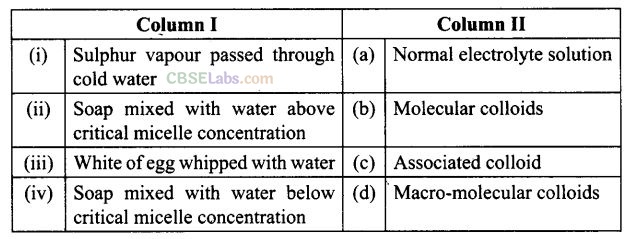
Solution:
(i -»b), (ii —> c), (iii —» d), (iv —> a)
(i) When sulphur vapour passed through cold water, it leads to formation of molecular colloids.
(ii) When soap is mixed with water above critical micelle concentration, it leads to formation of associated colloids.
(iii) White part of egg whipped with water is an example of macro-molecular colloids in which high molecular mass proteneous molecule acts as a colloidal particle.
(iv) Soap mixed with water below critical micelle concentration is known as normal electrolyte solution.
Question 68. Match the statement given in Column I with the phenomenon given in Column II.
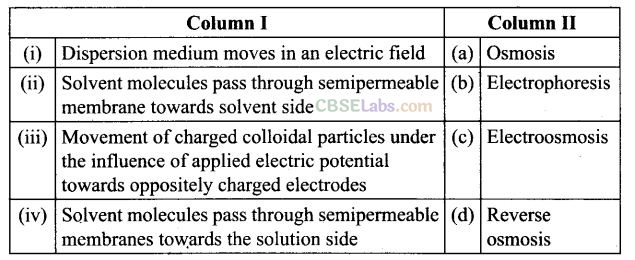
Solution:
(i —> c), (ii —» d), (iii-> b), (iv —» a)
(i) Dispersion medium moves in an electric field is known as electroosmosis.
(ii) Solvent molecules pass through semipermeable membrane towards
solvent side is known as reverse osmosis.
(iii) Movement of charged colloidal particles under the influence of applied electric potential towards oppositely charge electrodes is known as electrophoresis.
(iv) Solvent molecules pass through semipermeable membranes towards solution side is known as osmosis.
Question 69. Match the items given in Column I and Column II.

Solution:
(i -> b), (ii -» c), (iii -» d), (iv-> a)
(i) Lyophobic colloid (solvent hating colloid) are readily protected by small amount of electrolyte. These colloids are also stabilized by addition of lyophilic colloids which makes a protective layer around lyophobic sol. Hence, lyophilic sol are known as protective colloid.
(ii) Liquid-liquid colloid is also known as emulsion if they are partially miscible or immiscible liquids.
(iii) When FeCl3 is added to hot water, it leads to the formation of positively charged colloid.
(iv) When NaOH is added to FeCl3, it leads to the formation of negatively charged colloid.
Question 70. Match the types of colloidal systems given in Column I with the name given in Column II.
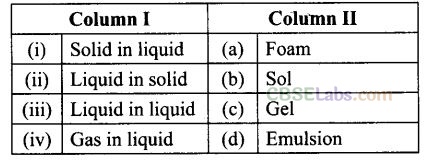
Solution:
(i -> b), (ii —»c), (iii —» d), (iv —> a)
Colloids are classified on the basis of types of dispersed phase and dispersion medium.

Question.71. Match the items of Column I and Column II.

Solution:
(i —> d), (ii -» c), (iii —> a), (iv —> b)
(i) Purification of colloid can be done by dialysis in which ions/particles are removed from solution through semipermeabie membrane.
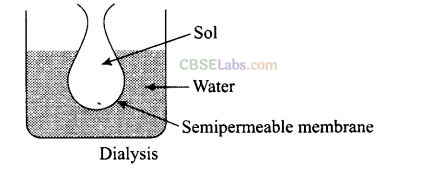
(ii) Peptisation is a process in which when small quantity of electrolyte (peptizing agent) is added to precipitate. It leads to formation of colloidal solution.
(iii) The process of removing of oily or greasy dirt from the cloth is done by emulsification.
(iv) Process of setting of colloidal particle is called coagulation. Electrophoresis is a process in which on applying electric potential to the electrodes dipped in sol, the oppositely charged particles of colloidal solution move towards oppositely charged electrodes, get discharged and precipitated.
Question 72. Match the items of Column I ahd Column II.

Solution:
(i —> d), (ii —> c), (iii —> a), (iv —> b)
(i) Butter is an example of dispersion of liquid in solid.
(ii) Pumice stone is an example of dispersion of gas in solid in which gas bubbles are pierced within solid particles.
(iii) Milk is a dispersion of liquid in which fats and protein are dissolved in milk.
(iv) Paint is an example of solid in liquid.
Assertion and Reason Type Questions
In the following questions, a statement of Assertion (A) followed by a statement of Reason (R) is given. Choose the correct option out of the following choices:
(a) Both Assertion and Reason are correct and the Reason is the correct explanation for Assertion.
(b) Both Assertion and Reason arc correct but Reason is not the correct explanation for Assertion.
(c) Assertion is correct but Reason is incorrect.
(d) Both Assertion and Reason are incorrect.
(e) Assertion is incorrect but Reason is correct.
Question 73. Assertion (A): An ordinary filter paper impregnated with collodion solution stops the flow of colloidal particles.
Reason (R): Pore size of the filter paper becomes more than size of colloidal particle.
Solution:
(c) Pore size of the filter paper becomes less than the size of colloidal particles hence colloidal particles do not flow through it.
Question 74. Assertion (A): Colloidal solutions show colligative properties.
Reason (R): Colloidal particles are large in size.
Solution:
(b) Colloidal particles are large in size and hence the number of particle is lesser than the true solution. The lesser number of particles causes lower colligative properties.
Question 75. Assertion (A): Colloidal solutions do not show Brownian motion.
Reason (R): Brownian motion is responsible for stability of sols.
Solution:
(e) Colloidal particles show Brownian movement and it is responsible for the stability of colloidal solution.
Question 76. Assertion (A): Coagulation power of Al
3+
is more than Na
+
Reason (R): Greater the Valency of the flocculating ion added, greater is its power to cause precipitation (Hardy-Schulze rule).
Solution:
(a) According to Hardy-Schulze law, the greater is the valency of the coagulating ion, the more is the power to coagulate the colloidal solution. Thus, coagulation power of Al
3+
is greater than that of
Na
+
.
Question 77. Assertion (A): Detergents with low CMC are more economical to use. Reason (R): Cleansing action of detergents involves the formation of micelles. These are formed when the concentration of detergents becomes equal to CMC.
Solution:
(a) Cleansing of clothes takes place by micellisation, it starts at CMC. The lesser is the CMC, the better and more economical is the detergent.
Long Answer Type Questions
Question 78. What is the role of adsorption in heterogeneous catalysis?
Solution:
The role of heterogeneous catalysts can be explained in terms of adsorption of reactants on the surface of the catalyst. The adsorption helps the reaction in the following ways:
(i) Adsorption increases the concentration of reactants on the surface of the catalyst. Due to increased concentration of the reactants, the reactions proceed rapidly.
(ii) Adsorbed molecules get dissociated to form active species like free radicals which react faster than molecules.
(iii) The adsorbed molecules are not free to move about and, therefore, they collide with other molecules on the surface.
(iv) The heat of adsorption evolved acts as energy of activation for the reaction (chemisorption).
Example:
Adsorption of molecules of the reactant at the active site .
Occurrence of chemical reaction on the surface of catalyst
Desorption of product molecules
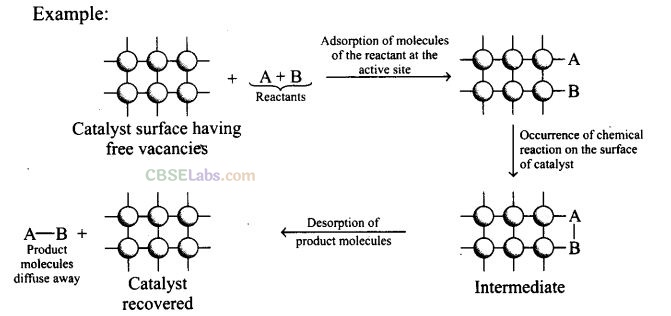
Question 79. What are the applications of adsorption in chemical analysis?
Solution:
Adsorption has the following applications in chemical analysis:
(i) In qualitative analysis: Certain qualitative tests such as the lake test for the confirmation of Al
3+
ions are based upon adsorption, i.e., Al(OH)
3
has the capacity to adsorb the colour of blue litmus from the solution.
(ii) In adsorption indicators: Many adsorption indicators are being used in volumetric analysis e.g., dyes such as eosin and fluorescein are used as adsorption indicators. In these methods, the dyes are adsorbed on the surfaces of certain precipitates (such as silver halides) which give characteristic colour at the end point.
(iii) In ion-exchange resins: The organic polymers containing groups like -COOH, -SO
3
H and -NH
2
, etc. possess the property of selective adsorption of ions from solutions. These are quite useful in the softening of water.
(iv) Separation of inert gases: Due to the difference in degree of adsorption of gases by charcoal, a mixture of noble gases can be separated by adsorption on coconut charcoal at different temperatures.
(v) In froth floatation process: A low grade sulphide ore is concentrated by separating it from silica and other earthly matter by adsorption using pine oil and frothing agent.
(vi) Chromatographic analysis: The chromatographic technique for purification used in analytical and industrial fields is based on the phenomenon of adsorption.
Question 80. What is the role of adsorption in froth floatation process used especially for concentration of sulphide ores?
Solution:
Sulphide ores are concentrated by froth floatation process. The finely divided ore is added to pine oil and water. Compressed air is bubbled through the mixture. The foam formed rises to the surface on which ore particles wetted with oil are adsorbed while earthy matter settles down at the bottom.
Question 81. What do you understand by shape selective catalysis? Why are zeolites good shape selective catalysts?
Solution:
The catalytic reaction which depends upon the pore structure of the catalyst and the size of the reactant and product molecules is called shape selective catalysis. Zeolites are good shape selective catalysts because of their honey comb like structures.
(i) Zeolites are microporous aluminosilicates of the general formula M
x/n
[(AlO
2
)
x
(SiO
2
)
y
]mH
2
O
(ii) Zeolites have an enormous surface area which is largely on the inside of the solid. The zeolites can permit the entry and exit of molecules of a certain size into the active regions within the holes.
(iii) They are used in petrochemical industries for cracking of hydrocarbons and isomerization.
(iv) The reactions in zeolites depend upon the size of the cavities (cages) and pores (tunnels) present in them. The pore size in zeolites generally varies between 260 pm and 740 pm.
(v) Zeolite catalyst known as ZSM-5 converts alcohols to gasoline. The alcohol is dehydrated in the cavities and the hydrocarbons are formed.
NCERT Exemplar Class 12 Chemistry Solutions
- Chapter 1 Solid State
- Chapter 2 Solution
- Chapter 3 Electrochemistry
- Chapter 4 Chemical Kinetics
- Chapter 5 Surface Chemistry
- Chapter 6 General Principles and Processes of Isolation of Elements
- Chapter 7 The p-Block Elements
- Chapter 8 The d- and f-Block Elements
- Chapter 9 Coordination Compounds
- Chapter 10 Haloalkanes and Haloarenes
- Chapter 11 Alcohols, Phenols and Ethers
- Chapter 12 Aldehydes, Ketones and Carboxylic Acids
- Chapter 13 Amines
- Chapter 14 Biomolecules
- Chapter 15 Polymers
- Chapter 16 Chemistry in Everyday Life